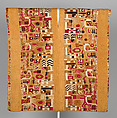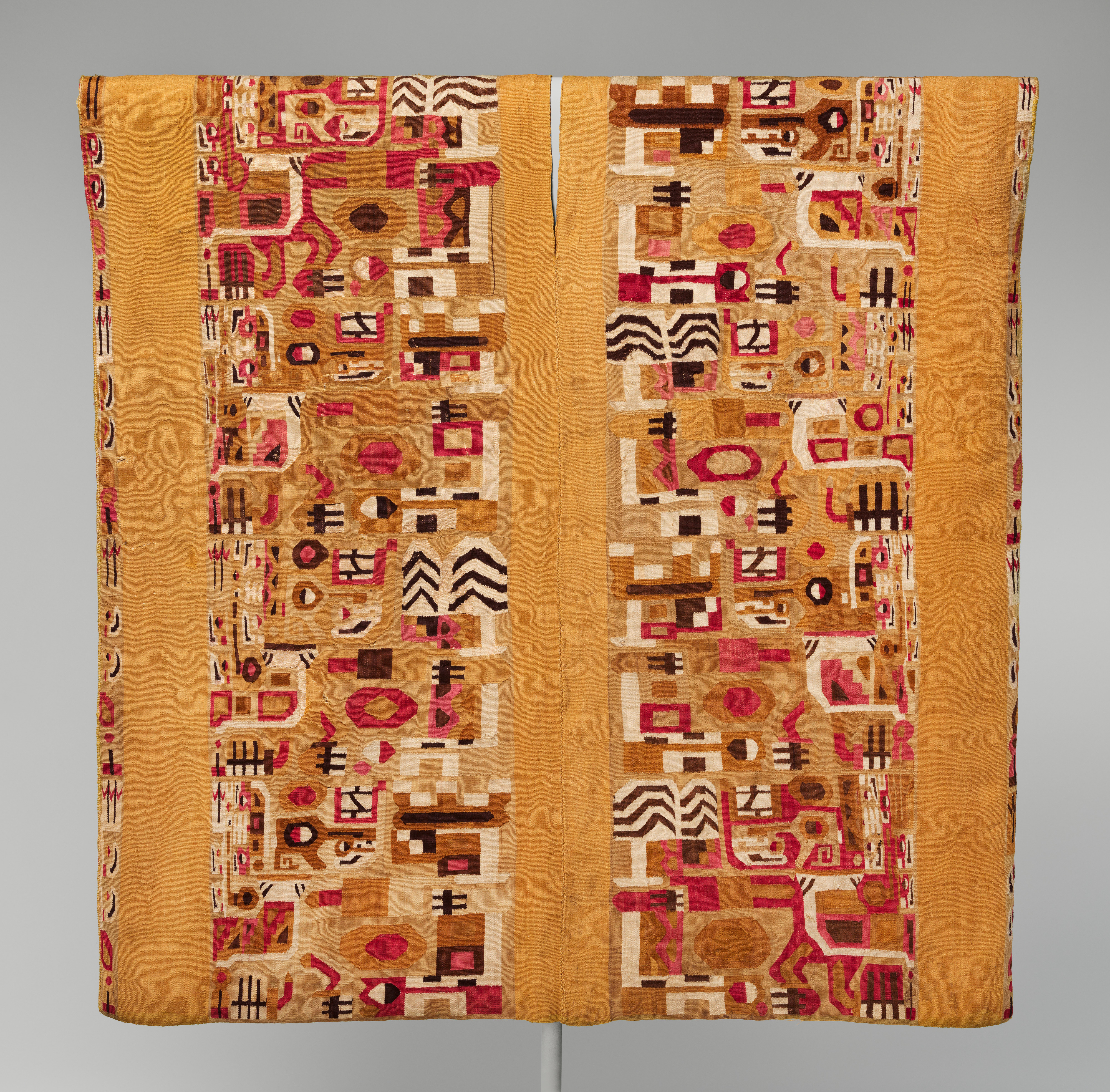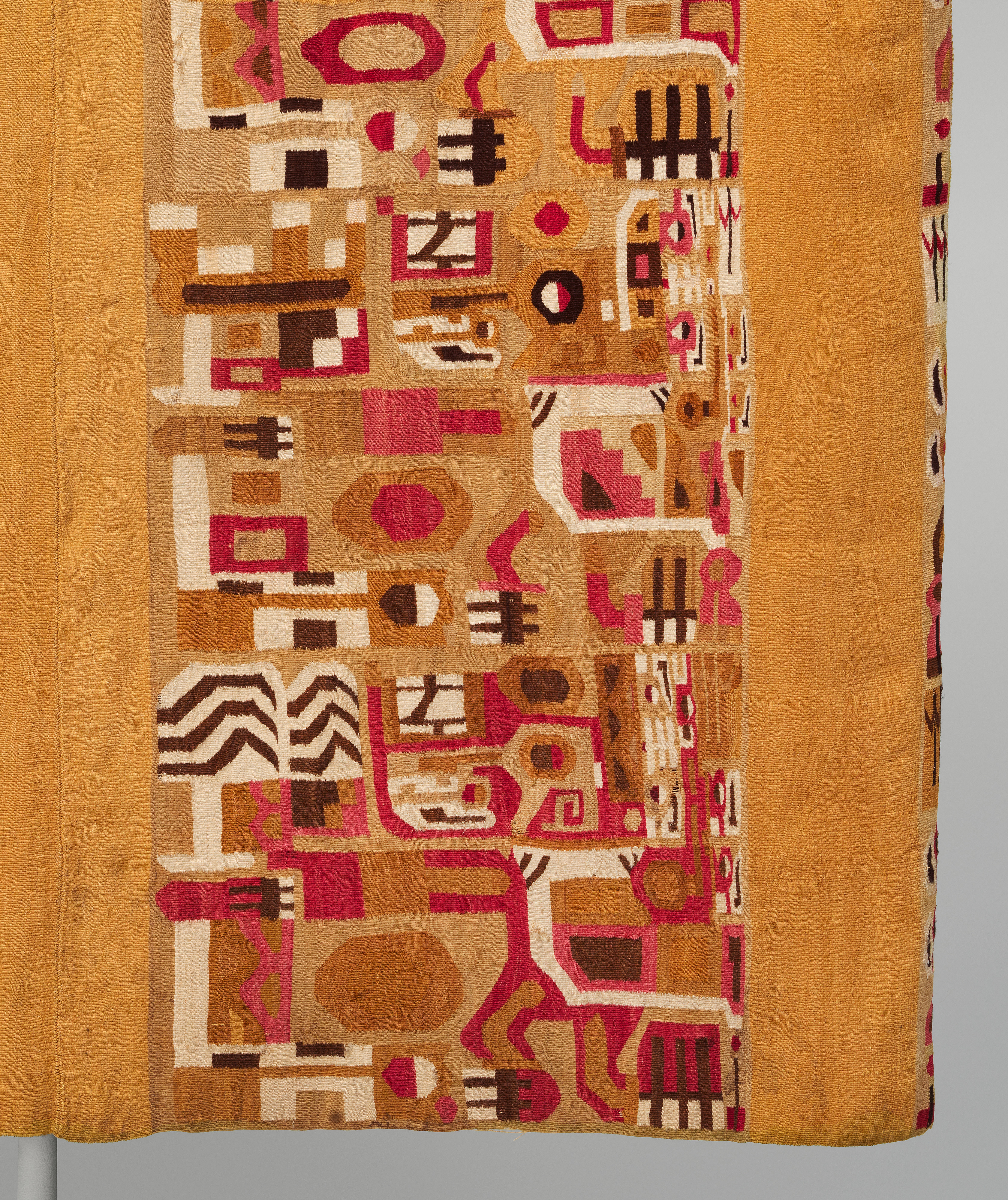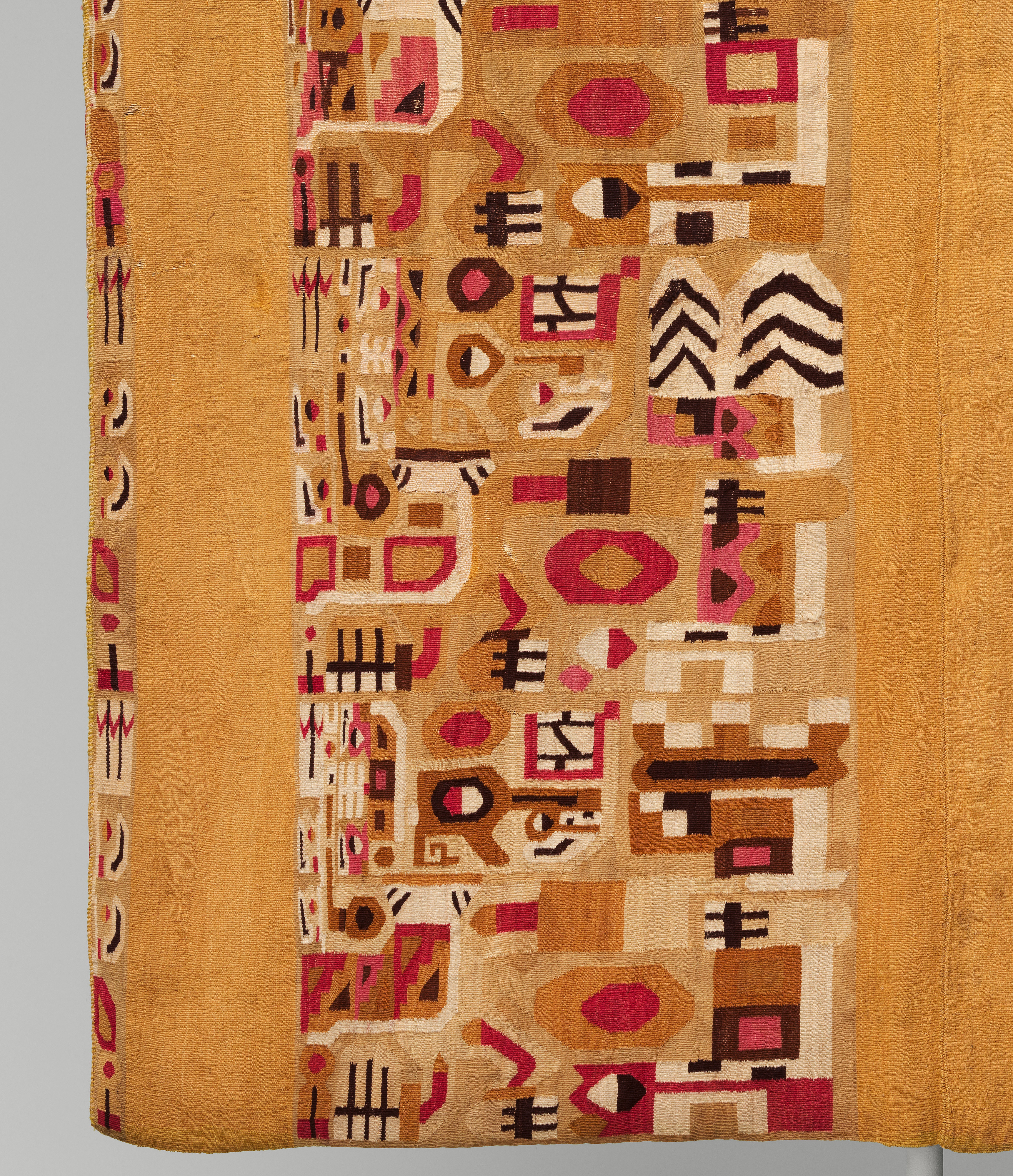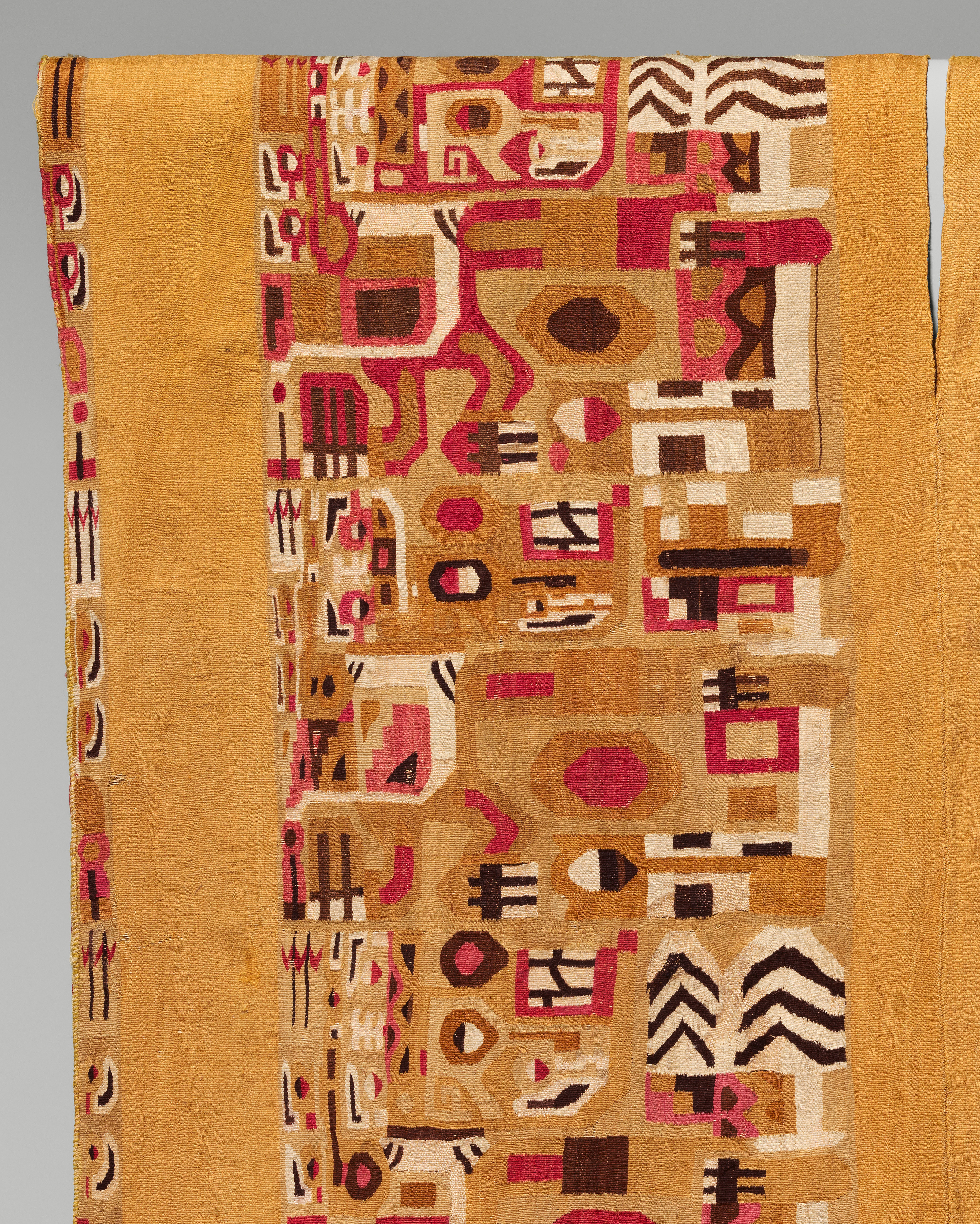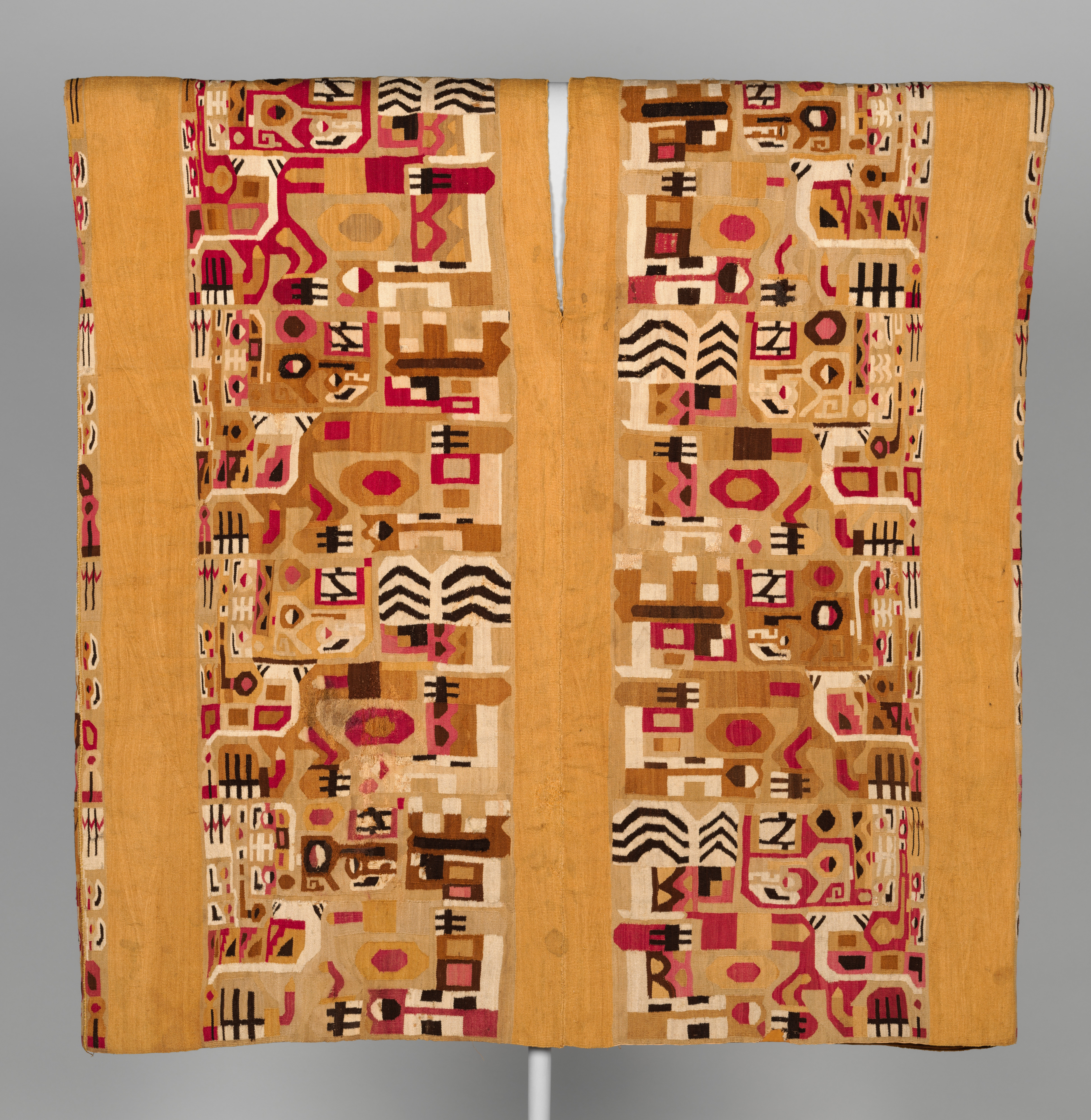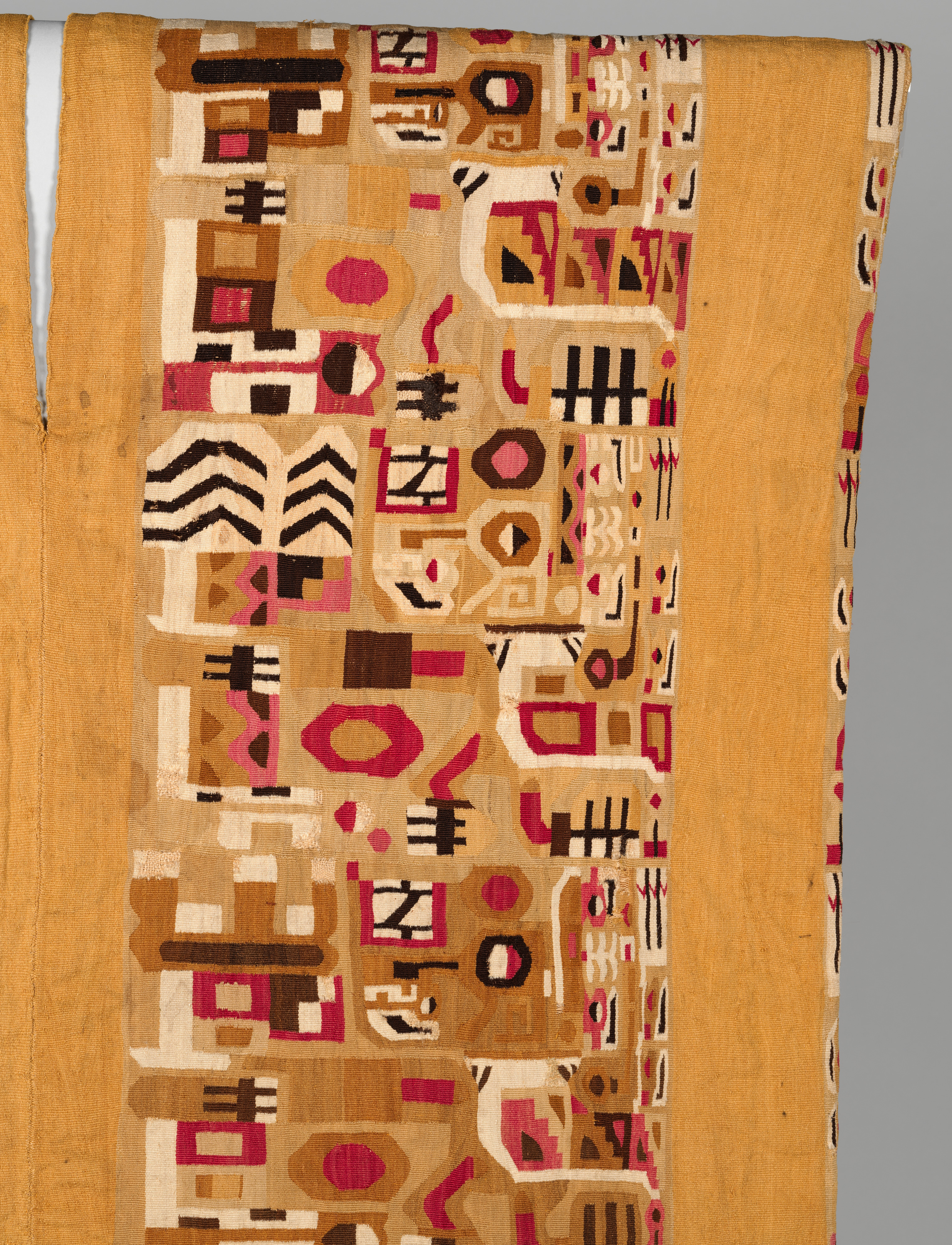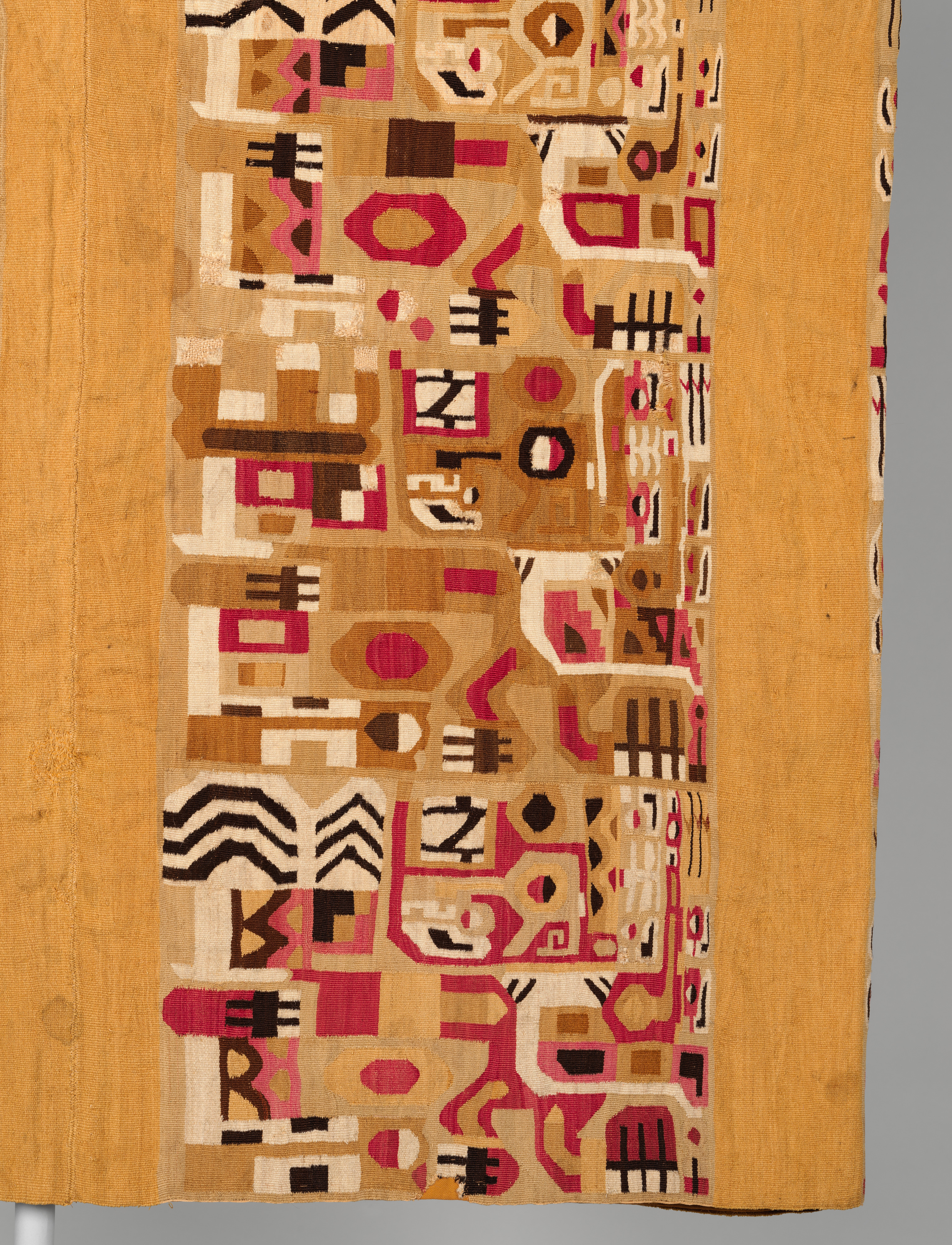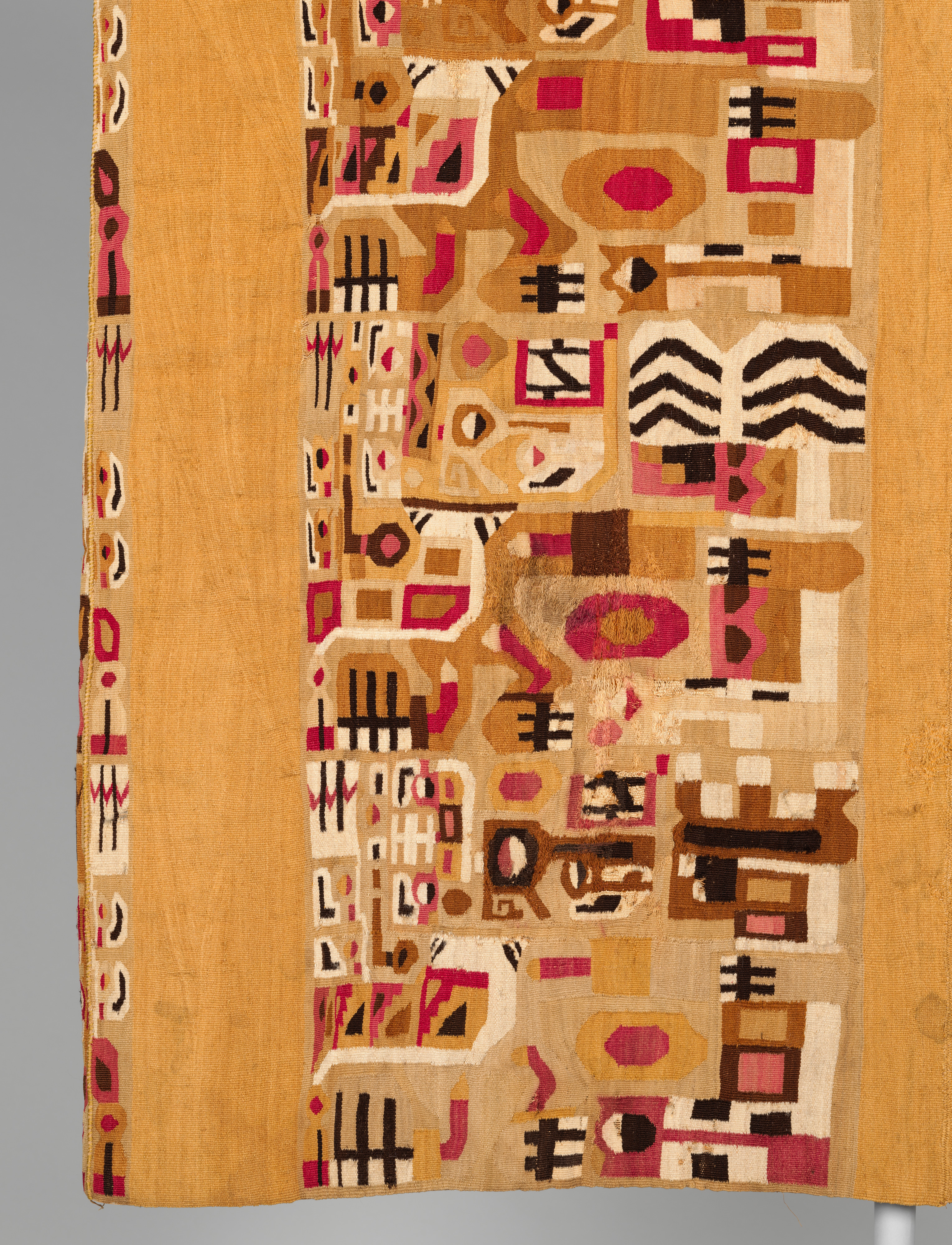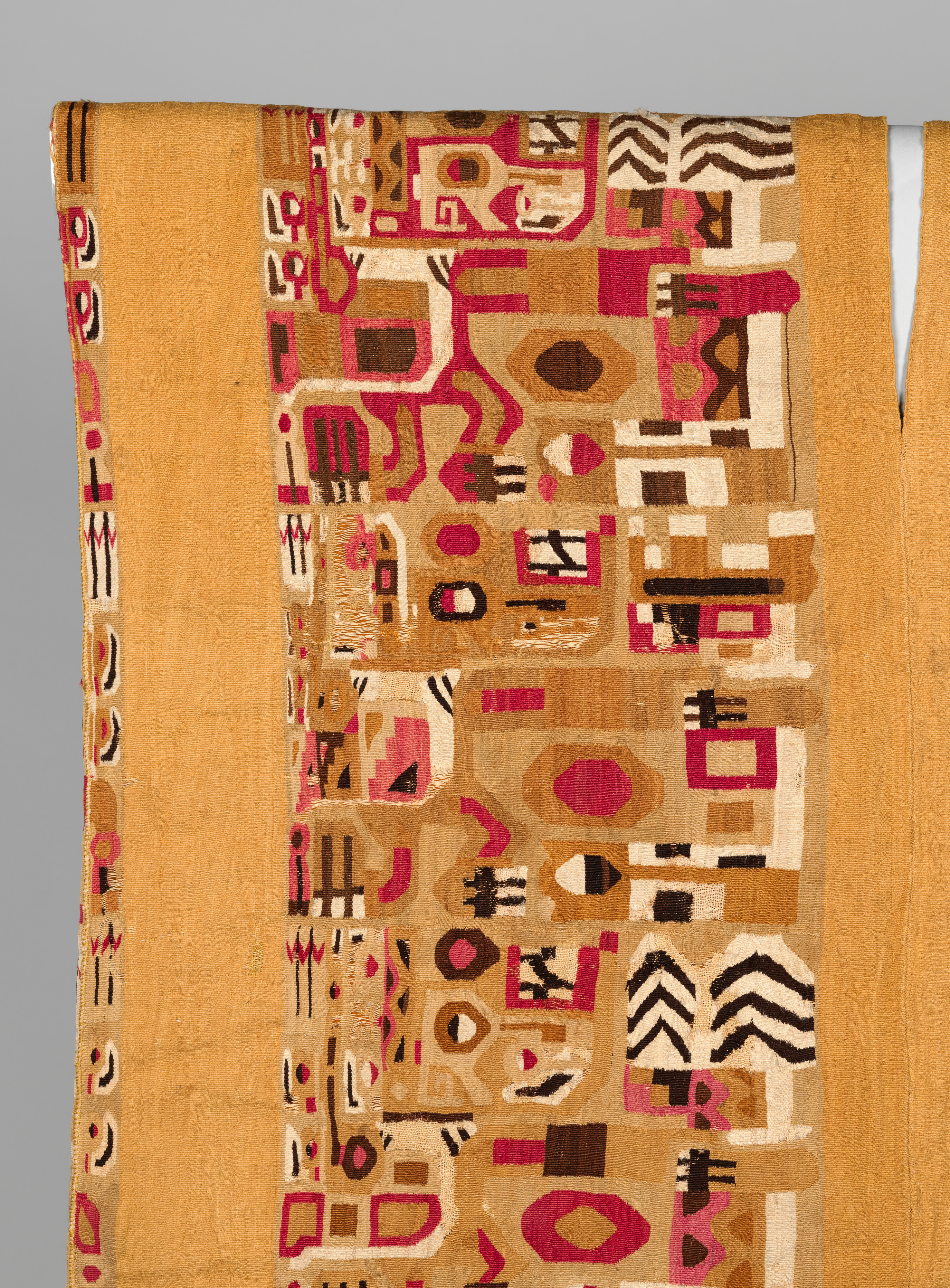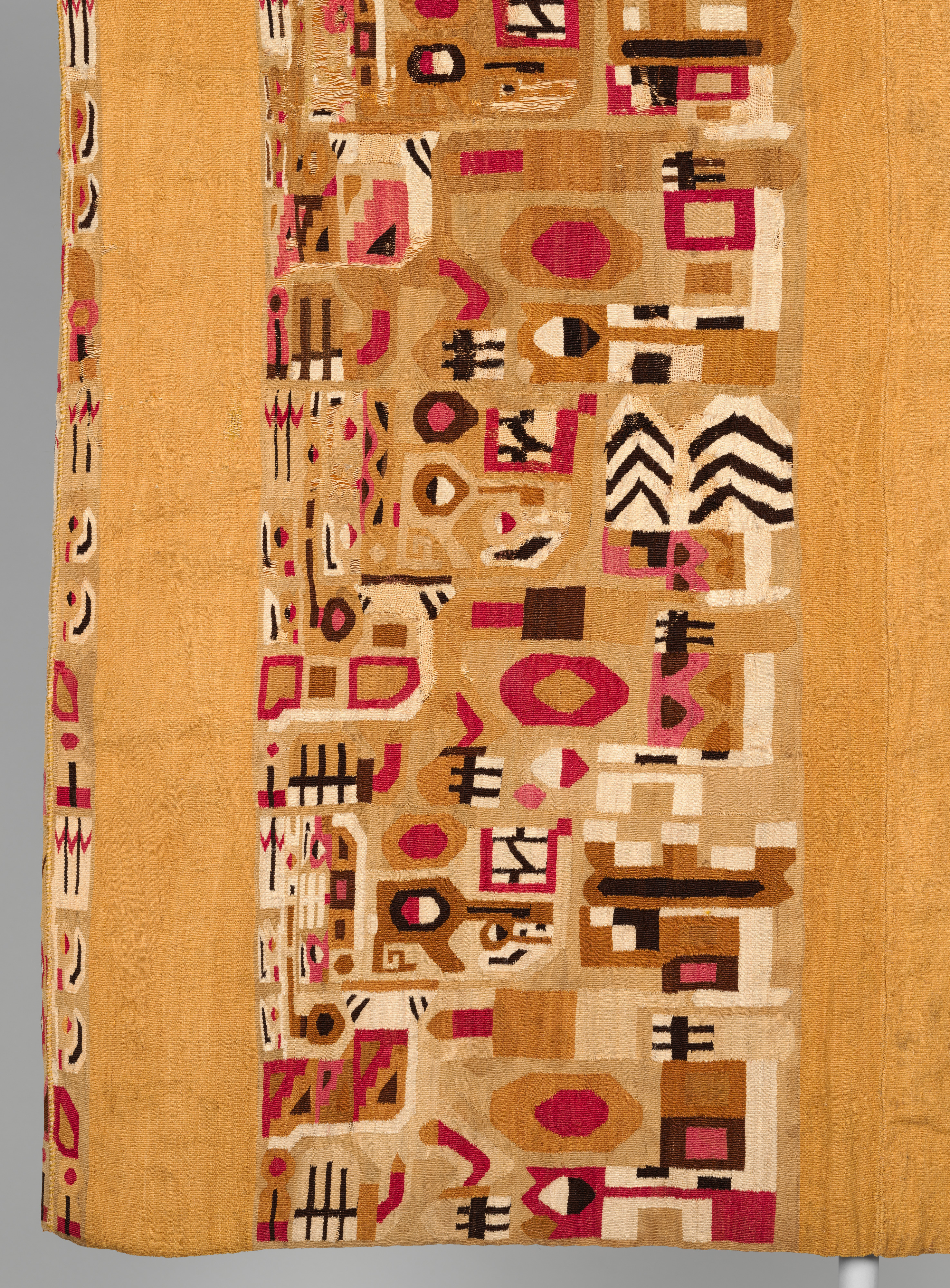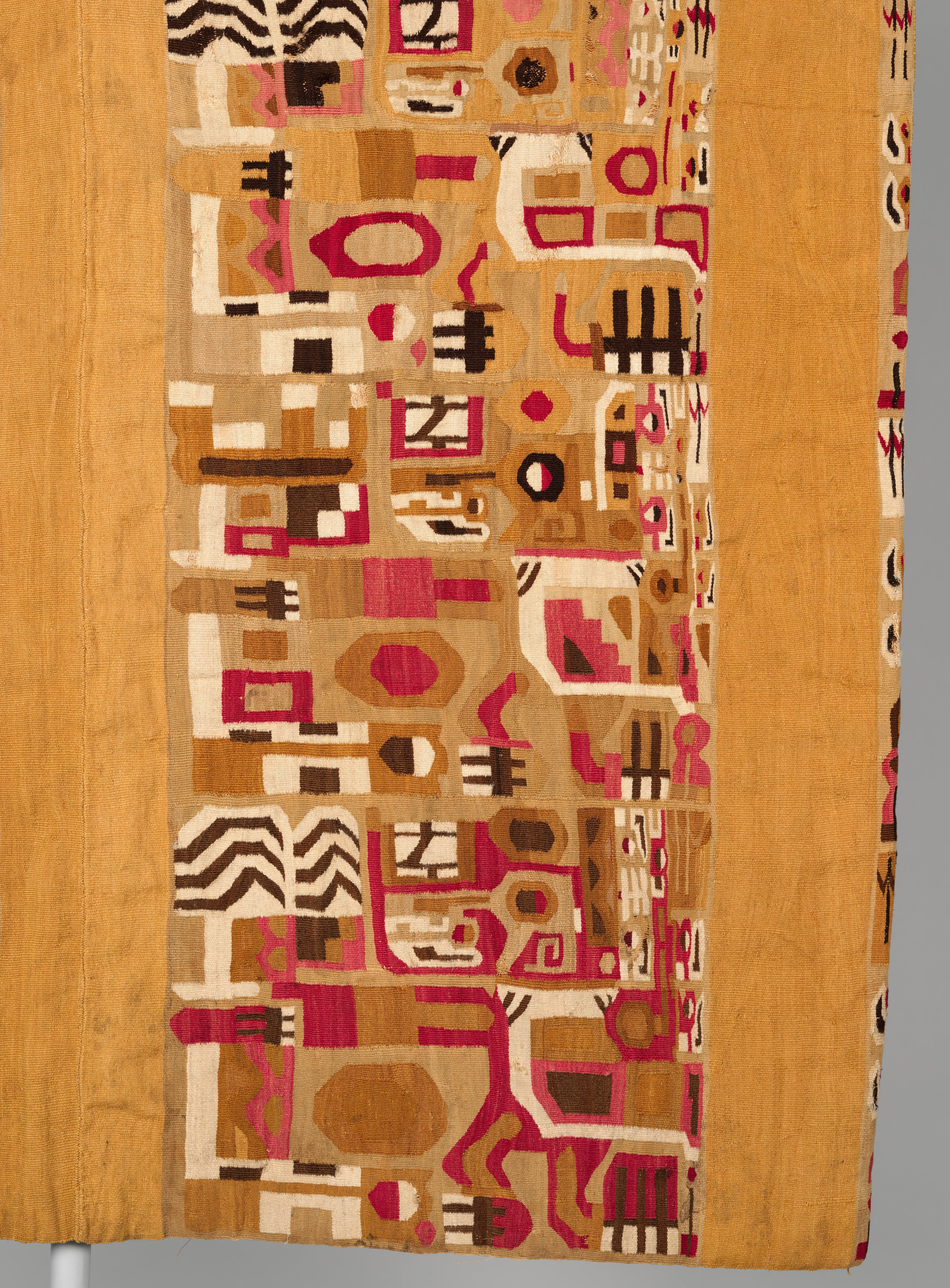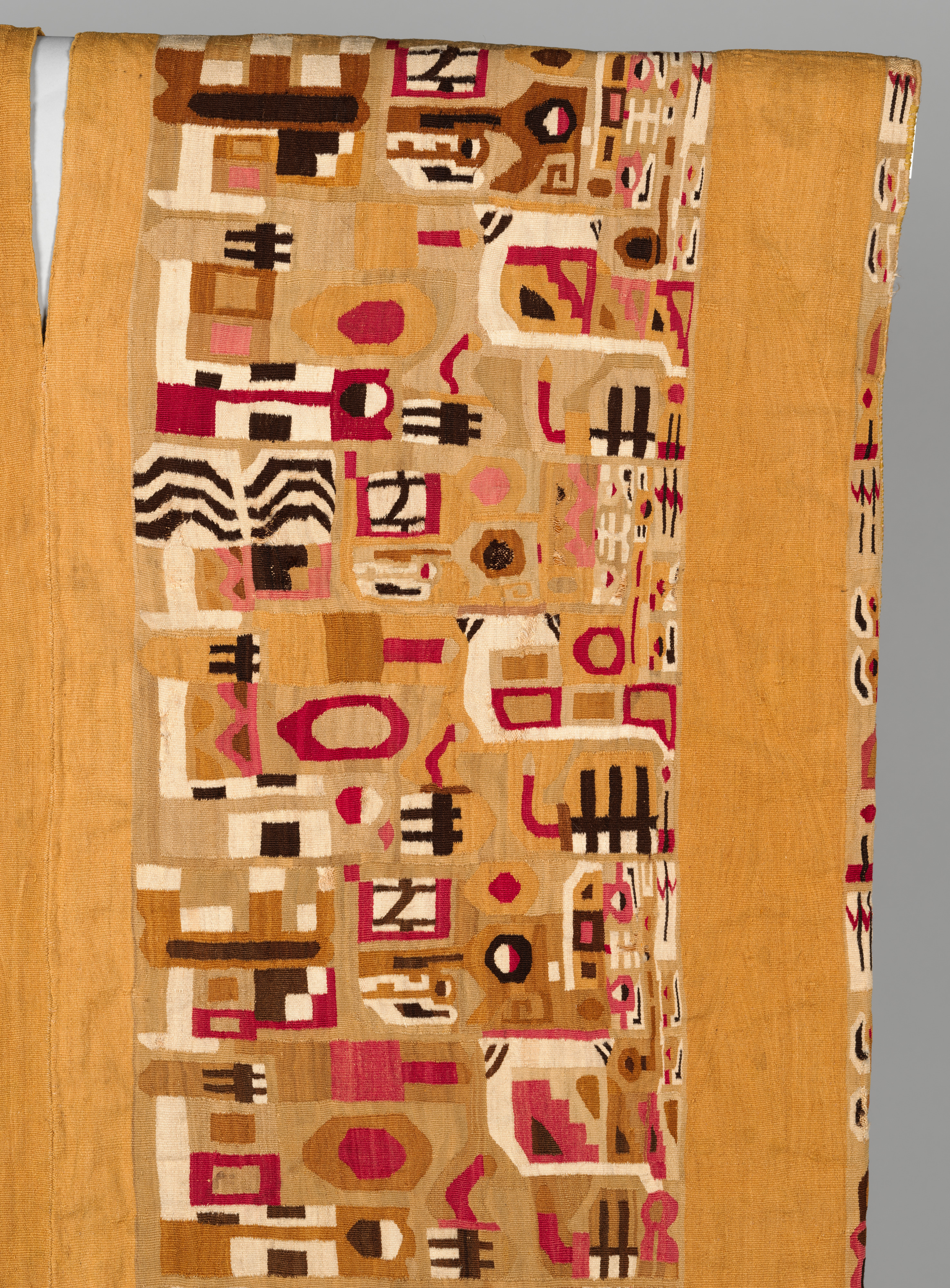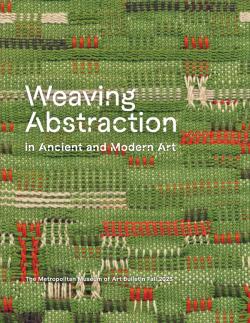Tunic
This outstanding Wari tunic consists of two woven panels stitched together—except at the center, to leave an opening for the head—to form a sleeveless, knee-length garment with a V-shaped neck opening. Both its front and back are decorated with columns of imbricated motifs that alternate with bands of plain, gold-like color. The design elements on this textile are so abstracted that they are illegible to most present-day viewers, making it a work that is visually reminiscent of Abstract Expressionism while remaining deeply Andean it its form and structure.
With their intricate designs and vivid colors, Wari tapestry tunics are some of the most striking textile creations of the Andes. Their unconventional use of distortion, abstraction, and deconstruction challenges the longstanding scholarly view of the arts of the indigenous Americas as uninventive, and subject to oppressing cultural norms. This tunic masterfully illustrates the level of skill and creativity reached by Wari artists.
From around 600 to 1000 A.D., the Wari ran an empire that expanded throughout most of what is now Peru. Born out of interactions between the Huarpa, a local group of the central highlands in present-day Ayacucho, and the Nasca people on the South Coast, the Wari Empire bridged multiple regions, cultures, and artistic practices. Wari administrators relied on outposts established in far-flung regions, from the desert coast to the tropical rainforest, thus gaining access to a multitude of valuable resources such as cotton, spondylus shell, and tropical bird feathers. In many ways, the Wari paved the way to the later Inca Empire: their knotted string recording system (khipu) and their road network were critical to the development and management of the Inca territory centuries after.
Over four centuries, Wari artists developed an artistic tradition that reached a degree of invention and diversity unmatched in the history of the Central Andes. In addition to portable objects such as brightly painted ceramics and small effigies in wood, stone, or metal, many Wari artworks were destined to be worn. Wari dignitaries are shown wearing colorful woven garments, headdresses, metal jewelry, mosaic earspools, and facial painting. It is essential to think of Wari textiles not simply as two-dimensional pictorial works, but also as garments meant to be worn in conjunction with other forms of body ornamentation. Tunics such as the present example would have come to life on the body, its fantastically complex imagery animated through movement, providing a spectacular visual and, for some, tactile experience for the wearer and the beholders.
As in the later Inca Empire, Wari tapestry tunics were standardized in their shape, dimensions, construction, layout, and motifs. Given this homogeneity, scholars believe that the production of Wari tapestry tunics was supervised by imperial administrators, an interpretation that is supported by the fact that the Incas produced and distributed their similarly standardized tapestry tunics in tightly controlled settings (Rowe 1978). Colonial sources indicate that finely woven Inca tunics, known as uncu in Quechua, were used as status markers, stored as wealth, and gifted in diplomatic contexts. Evidence points to a similar uses of tapestry tunics in the Wari Empire.
Indeed, it is likely that only members of the elite would have owned Wari tunics of this quality, considering the resources necessary to their production. The warp (the threads that form the base) was generally made of cotton, grown in coastal regions, while the weft (the threads that form the design) was made of camelid wool from the highlands. Once these yarns were gathered and cleaned, Wari weavers prepared natural dyes to color them. They favored cochineal, an insect found on cacti, for its bright red colors such as the magenta seen on this tunic. After dyeing, the yarn was spun and set on a loom. Making Wari tunics was such a labor-intensive enterprise that it usually required collaboration, with sometimes two weavers working on the same piece. Weaving was done in small sections at a time: if examining closely the yellow bands on this tunic, one can see “lazy lines,” which are the delimitations of these working segments (Bird and Skinner 1974: 7; Bergh 1999: 25).
Despite the similarities that exist between Wari and Inca tapestry tunics, the motifs woven on them differ greatly. In the Inca Empire, uncu were usually decorated with simple geometric forms, while in the Wari Empire, they bore figurative and detailed designs. Hence, if the complex motifs woven on this tunic might at first seem abstract, a closer look reveals that it consists of eight mythical figures in the form of winged felines. They are depicted in profile, holding a staff in their hand, with a patterned textile on their back. The composite felines are rendered with two variants of staff and textile that alternate on the tunic. Each type is woven in one of two colors: cream and magenta for one, and yellow and brown for the other. The imagery on this tunic is therefore extremely playful, as it mixes iconographic details with different hues on the same base model—the motifs being thus both repetitive and singular.
The overall design of Wari tunics is guided by principles of symmetry and duality, with motifs repeated in multiples of two (Bergh 2012). On this example, the design is reproduced sixteen times in total, which is also the number of niches in Wari ritual D-shaped structures (Bragayrac 1991; Williams and McEwan 2012: 74). Movable objects and ancestral bodies may have been put on display in those niches, hence the number sixteen may also reference the number of figures presiding over Wari ritual spaces. While this similarity might be a simple coincidence, the prevalence of even numbers in the design of Wari tunics points to them having a deeper meaning.
Wari objects in other media, such as painted ceramic vessels and carved wooden containers, were also decorated with winged felines. They commonly appear on Wari artworks and form part of a larger iconographic repertoire shared with Tiwanaku and earlier Andean cultures (Isbell et al. 2018), together with bird-headed and human-headed figures also holding staffs in their hands. Elements from the three species—human, avian, and feline—appear on each of these entities: for example, this feline has bird wings but also human arms and hands. The role and significance of these composite beings in Wari beliefs remains unknown, but they seem to have been connected in some way, as if all were variants of the same original being able to transform and take on these different identities.
At least two other known Wari tunics bear a winged feline motif identical to this one (King 1965: cat. 20; Bergh 2009: fig. 7), but the present example differs from the others in that it is the only one to have motifs that are distorted and compressed, sometimes reaching complete abstraction. The head of the feline is tilted upward, its only visible arm elongated, its feet placed perpendicular to each other, and its staff bent at a ninety-degree angle. As the separation between each figure is unclear, the viewer can only distinguish imbricated, presumably meaningless shapes from afar. Compared to Wari tapestry garments that have a clear grid layout on which motifs and colors repeat in a repetitive sequence, here the decoration of the tunic fails to create a pattern that would give points of reference to the viewer, or a rhythm to rely on. This results in a much more visually complex and deconstructed design, pushing the abstraction of the winged felines even further.
The reason behind this distortion of motifs on Wari textiles has long puzzled scholars (Sawyer 1963). It cannot be due to technical limitations, given the skill of Wari weavers. Rather, this formal expansion and compression was intentional, especially as it was limited to certain motifs: for instance, no distortion occurs on Wari tunics decorated with skulls. Was this mode of representation meant to reinforce a visual effect of the tunic when worn and in movement? Was it intended to be observed after consuming psychotropic substances that might have impacted the perception of certain motifs? Whatever the reason may be, it is undeniable that Wari tapestry tunics were esoteric objects in the Andes, their complex iconography perhaps only fully understood by a select few (Stone-Miller 1987). Yet in its masterful interplay of formal imagination with intricate weaving, its overall message of imperial power would be lost on no one.
Louise Deglin, Sylvan C. Coleman and Pam Coleman Memorial Fund Fellow, Arts of the Ancient Americas, 2022
References and Further Reading
Bergh, Susan E. 1999. “Pattern and Paradigm in Middle Horizon Tapestry Tunics.” Ph.D. Dissertation, New York, NY: Columbia University.
Bergh, Susan E. “The Bird and the Camelid (or Deer): A Ranked Pair of Wari Tapestry Tunics.” In Tiwanaku: Papers from the 2005 Mayer Center Symposium at the Denver Art Museum, edited by Young-Sánchez, 225–46. Denver: Denver Art Museum, 2009.
Bergh, Susan E. 2012. “Tapestry-Woven Tunics.” In Wari: Lords of the Ancient Andes, edited by Susan E. Bergh, 159–91. New York, NY and Cleveland, OH: Cleveland Museum of Art and Thames & Hudson.
Bird, Junius, and Milica Dimitrijevic Skinner. 1974. “The Technical Features of a Middle Horizon Tapestry Shirt from Peru.” Textile Museum Journal 4 (1): 5–13.
Bragayrac D., Enrique. “Archaeological Excavations in the Vegachayoq Moqo Sector of Huari.” In Huari Administrative Structure: Prehistoric Monumental Architecture and State Government, edited by William H. Isbell and Gordon F. McEwan, 71–80. Washington, D.C.: Dumbarton Oaks Research Library and Collections, 1991.
Conklin, William J. 1986. “The Mythic Geometry of the Ancient South Sierra.” In The Junius B. Bird Conference on Andean Textiles, April 7th and 8th, 1984, edited by Ann P. Rowe, 123–37. Washington, D.C: Textile Museum.
Due to rights restrictions, this image cannot be enlarged, viewed at full screen, or downloaded.
This artwork is meant to be viewed from right to left. Scroll left to view more.
